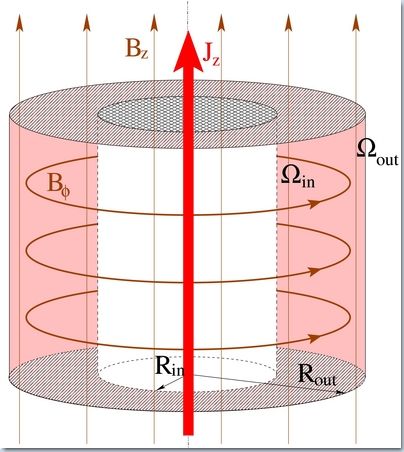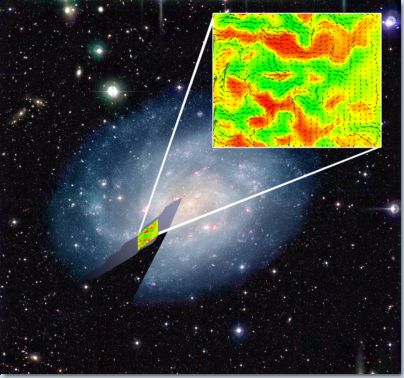|
PROMISE
The magnetorotational instability (MRI) has turned out to be a universal and efficient instability solving the angular-momentum problem in star formation, explaining the enormous energy output of quasars. It also generates the turbulence of the interstellar medium eventually leading to extended galactic magnetic fields (right Figure). Today it is a widely accepted phenomenon that the presence of weak magnetic fields makes all astrophysically relevant shear flows unstable und turbulent. It is nearly unknown in experimental physics though. The verification in the laboratory will be a major step of understanding the instability and the route to turbulence.
Investigations on high-performance computers delivered the parameters for the Taylor-Couette experiment. The potential capabilities of such an experiment have been demonstrated on a special international conference. The results also implied that the design will not make use of liquid sodium and a purely vertical field, but employ liquid gallium and a magnetic field with a more complex geometry.

Sketch of the experimental setup (40 cm high, 16 cm diameter). Between two concentric cylinders with different rotation speeds, liquid gallium will be threaded by a magnetic field. The field has a vertical component as well as a toroidal component (horizontal rings). Currents (J) of about 4000 A will generate the field.
|
|

Interstellar turbulence in a galaxy generated by the MRI. Numerical simulations with the super-computer SANSSOUCI of the AIP taken from the PhD thesis by N. Dziourkevitch.
|
Our most recent computations showed in particular that a successful experiment may use a spiral geometry of the magnetic field (see references below and left figure). If the the field lines have an angle of 45° with the vertical, the critical Reynolds number for the onset of the MRI reduced by several order of magnitude compared with the vertical-field case. The Reynolds number becomes independent of the magnetic Prandtl number of the liquid metal. We can thus use a gallium-indium-tin alloy which is much easier to handle at much reduced costs. The investigation of such field geometries is motivated by astrophysical problems in which poloidal magnetic fields always accompany toroidal fields. The results will have implications for the stability even for cold, whence weakly ionized, star formation regions.
All this lead to the idea of constructing an MRI experiment being the world's first specially devoted to this instability. It is a common project of two institutes of the Leibniz Gemeinschaft. The collaboration of the magneto-hydrodynamics groups of the AIP and the Forschungszentrum Rossendorf has a long-term fruitful history especially of designing an experiment capable of showing the MRI.
Publications
Rosner R., Rüdiger G., Bonanno A. (eds.):
"MHD COUETTE FLOWS: experiments & models"
American Inst. Phys. Conf. Proc. Vol. 733 (2004)
Rüdiger G., Hollerbach R:
"THE MAGNETIC UNIVERSE:
Geophysical and astrophysical dynamo theory"
Wiley-VCH Berlin (2004)
Hollerbach R., Rüdiger G.:
"A new type of magnetorotational instability"
Phys. Rev. Lett., subm. (2005)
Rüdiger G., Hollerbach R., Schultz M., Shalybkov D.:
"The stability of MHD Taylor-Couette flow with current-free spiral magnetic fields between conducting cylinders"
Astron. Nachr. 326, 409 (2005)
|


 last change 2005 December 15, R. Arlt
last change 2005 December 15, R. Arlt


